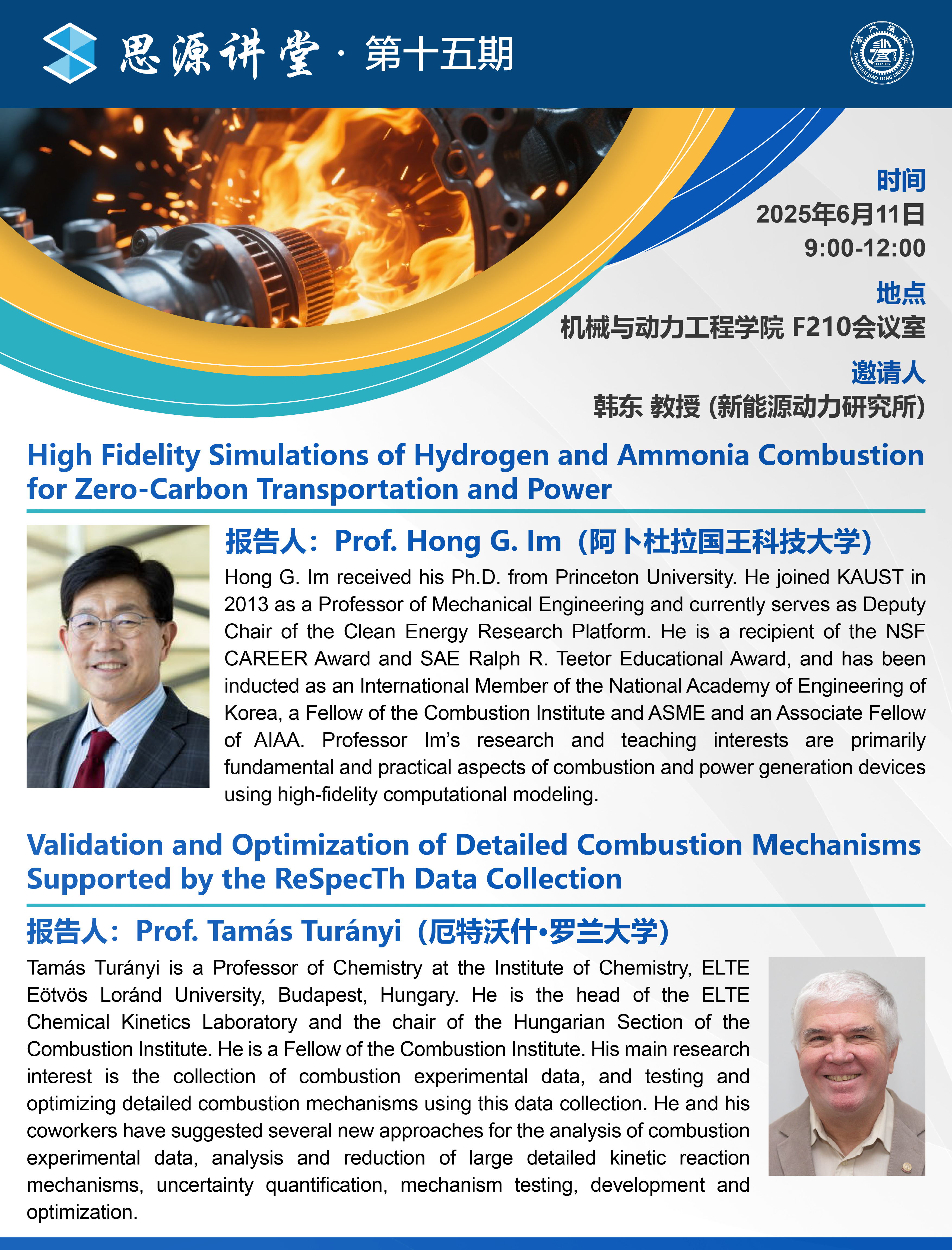题目:High Fidelity Simulations of Hydrogen and Ammonia Combustion for Zero-Carbon Transportation and Power/Validation and Optimization of Detailed Combustion Mechanisms Supported by the ReSpecTh Data Collection
时间:2025年6月11日 9:00-12:00
地点:williamhill威廉希尔官网 F210会议室
邀请人:韩东 教授(新能源动力研究所)
报告题目:High Fidelity Simulations of Hydrogen and Ammonia Combustion for Zero-Carbon Transportation and Power
报告人:Prof. Hong G. Im(阿卜杜拉国王科技大学)
Biography

Hong G. Im received his Ph.D. from Princeton University. He joined KAUST in 2013 as a Professor of Mechanical Engineering and currently serves as Deputy Chair of the Clean Energy Research Platform. He is a recipient of the NSF CAREER Award and SAE Ralph R. Teetor Educational Award, and has been inducted as an International Member of the National Academy of Engineering of Korea, a Fellow of the Combustion Institute and ASME and an Associate Fellow of AIAA. Professor Im’s research and teaching interests are primarily fundamental and practical aspects of combustion and power generation devices using high-fidelity computational modeling.
Abstract
Hydrogen and ammonia as a fuel has attracted increasing research interests in recent years due to their relevance to viable e-fuels towards carbon-neutral power and transportation. Despite the simplicity in oxidation pathways, combustion of hydrogen and ammonia involves pronounced effects of fast-diffusing major and intermediate species, leading to interesting flame dynamics in turbulent and high pressure conditions. This presentation will provide an overview of recent studies at KAUST on hydrogen and ammonia combustion from fundamental turbulent characteristics using direct numerical simulations to reveal local structures and statistical characteristics of turbulent premixed flames to new internal combustion engine concept using pre-chamber with gaseous fuels. Recent developments of reduced order models using machine learning for high fidelity simulations will also be briefly discussed.
报告题目:Validation and Optimization of Detailed Combustion Mechanisms Supported by the ReSpecTh Data Collection
报告人:Prof. Tamás Turányi(厄特沃什·罗兰大学)
Biography

Tamás Turányi is a Professor of Chemistry at the Institute of Chemistry, ELTE Eötvös Loránd University, Budapest, Hungary. He is the head of the ELTE Chemical Kinetics Laboratory and the chair of the Hungarian Section of the Combustion Institute. He is a Fellow of the Combustion Institute. His main research interest is the collection of combustion experimental data, and testing and optimizing detailed combustion mechanisms using this data collection. He and his coworkers have suggested several new approaches for the analysis of combustion experimental data, analysis and reduction of large detailed kinetic reaction mechanisms, uncertainty quantification, mechanism testing, development and optimization.
Abstract
A database of combustion experimental data was set up in 2014 at the web address ReSpecTh.hu. Over the last ten years, the data collection has expanded to 163,000 data points in 3,615 data files, related to the combustion of hydrogen, syngas, methanol, ethanol, methane, ethylene, H2/O2/NOx, syngas/NOx, methanol/NOx, ammonia, butanol, and pentane. The collected data include ignition delay times measured in shock tubes and rapid compression machines, laminar burning velocities, and concentrations measured in shock tubes, flow reactors, jet stirred reactors (JSRs) and burner-stabilized flames. Based on this data collection, the performance of the recently published reaction mechanisms for each fuel was compared, and the best ones were selected. These best ones were further improved by updating the critical rate parameters or using systematic mechanism optimization. We have proposed a series of methodical improvements for determining the uncertainty of the experimental data, and the uncertainty domain of the rate parameters of detailed combustion mechanisms. The ReSpecTh website also offers a collection of combustion mechanisms and a suite of freely available computer codes for uncertainty quantification, uncertainty analysis, and also for the validation, analysis, optimization, and reduction of detailed reaction mechanisms.
